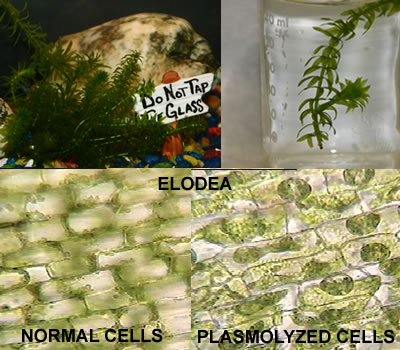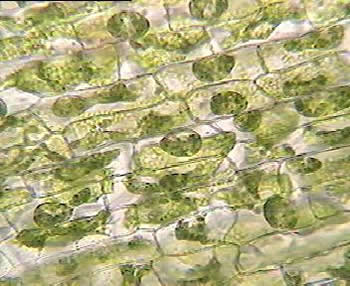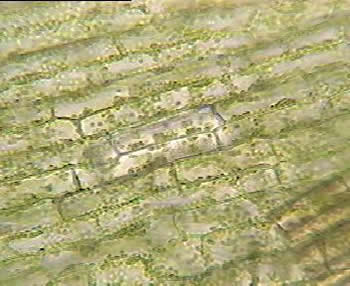Plasmolysis of Elodea
SED 695B; Fall 2005
Early Plasmolysis
Late Plasmolysis

Topics Addressed:
-
Osmosis and Diffusion
-
Concentration Gradients
-
Hypertonic, Hypotonic, Isotonic Solutions
-
Plant Cell Structure
Description of Investigation
Observation of a leaf of the water plant Elodea
Standards addressed:
BIOLOGY
Cell Biology
1. a. Students know cells are enclosed within semipermeable membranes that regulate their interaction with their surroundings.
SEVENTH GRADE LIFE SCIENCE
Cell Biology
1. a. Students know cells function similarly in all living organisms.
1. b. Students know the characteristics that distinguish plant cells from animal cells, including chloroplasts and cell walls.
under normal conditions with a microscope.
Observation of plasmolysis when the leaf is flooded with 6%
salt water.
Further observations when the plant leaf is rehydrated
with distilled water.
Materials:
- Microscope
- Elodea in aquarium water
- Slides and Cover slips
- Distilled water
- 6% NaCl solution (salt water)
- Paper towels or tissues
Procedure:
- Prepare a wet mount of one leaf from the water plant Elodea using the water in which it is kept.
- Observe the cells under normal conditions, and make a sketch of what you see.
- While observing the leaf under the microscope, wick a solution of 6% NaCl (sodium chloride) across the slide.
- Sketch your observations.
- With the same leaf, try wicking distilled water across the slide.
- Record your observations.
Study Guide:
Questions:
- Compare the location of chloroplasts in normal and plasmolyzed cells.
- What was the cause for the change in the location of the chloroplasts in the two solutions?
- Did the Elodea cell change shape? Why or why not?
- Describe the location of the chloroplasts when the plasmolyzed cell was flooded with distilled water?
- What was the cause for the change seen with distilled water?

The technique of "wicking" is used to draw a solution across the specimen on a slide. By placing a piece of tissue or paper towel at one edge (right) and dropping the solution at the edge of the other side (left), the solution is drawn or "wicked" across the specimen.


References & Links:
Pleasant Grove Junior High, Utah